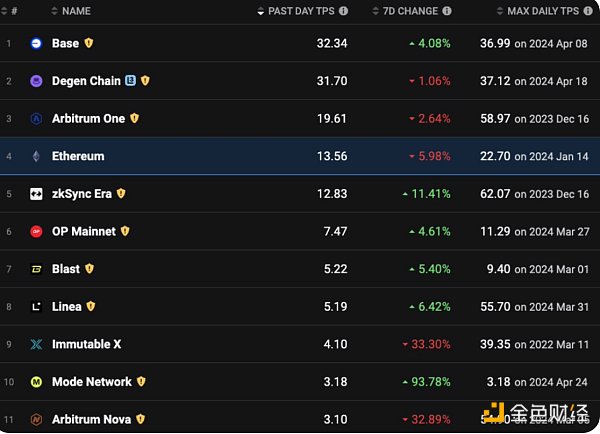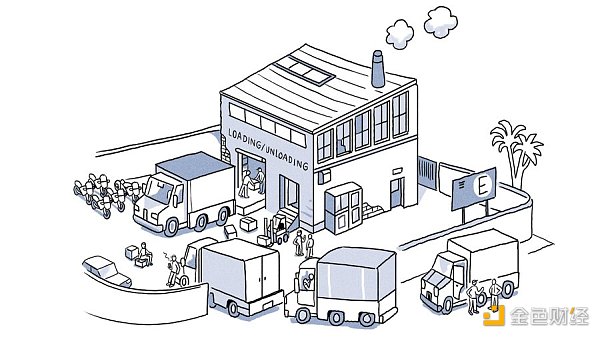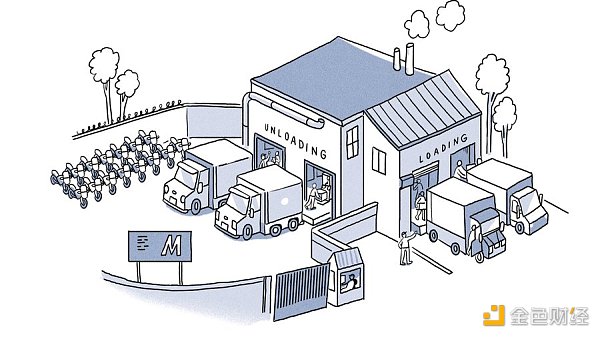Author: Decentralised.Co Source: X, @Decentralisedco Translation: Shan Ouba, Golden Finance
Transaction scalability has always been a hot topic of discussion in the industry. In the past few weeks, we have been discussing how Monad can help improve transaction processing speed (TPS). This article explains in detail how Monad works.
TPS is a metric we have been paying attention to. We hope that blockchains can support higher TPS to accommodate more users and applications. The figure below shows the TPS numbers for Ethereum and L2. So far, no chain has broken the 100 TPS mark. It should be noted that TPS is a general term used to measure scalability. Since not all transactions are equally complex, the pure TPS data is not accurate enough. But for convenience, we still regard TPS as an indicator of scalability.

What are the ways to improve TPS?
One way is to build a brand new system from scratch like Solana. Solana sacrifices compatibility with EVM in exchange for speed. It uses multi-threaded execution instead of single-threaded execution (which can be compared to multi-core CPU and single-core CPU), processes transactions in parallel, and uses different consensus mechanisms.
The second way is to use off-chain execution and use a centralized sorter to scale Ethereum.
The third approach is to break the EVM into separate components and optimize them for scalability.
Monad, a newly raised $225 million EVM-compatible L1 blockchain, chose to build the EVM from scratch rather than using an existing version. Monad takes the third approach to scalability.
Below we discuss some of the major changes introduced by Monad.
Parallel Execution
The Ethereum Virtual Machine (EVM) executes transactions serially. The next transaction must wait until the previous transaction is finished. Here’s an example: Imagine a platform for a motorcycle assembly warehouse. Multiple trucks arrive with motorcycle parts (each truck is loaded with all the parts needed to build 50 motorcycles). The assembly warehouse has four different functions, each of which is handled by a dedicated team - unloading, sorting, assembly, and loading.

In the current EVM setup, there is only one platform and one spot for loading and unloading. So when a truck stops, motorcycle parts are unloaded, sorted, assembled, and loaded on the same truck. While the sorting team works, the other teams are waiting. So if their work is considered as different slots, each team will only work once in every four slots. This leads to serious inefficiencies and highlights the need for a more streamlined approach.
Now imagine there are four platforms with separate loading and unloading areas. Even if the unloading team can only handle one truck at a time, they don't have to wait for the next three slots to work. They can just move to the next truck and start working.
The same goes for the sorting, assembly, and loading teams. When a truck is finished unloading, it drives to the loading area and waits for the loading team to load the assembled motorcycles. So a warehouse with only one platform and loading area will perform all operations sequentially, while a warehouse with 4 platforms and different loading areas can process tasks in parallel.
Sponsored Business Content

You can think of Monad as a warehouse infrastructure with multiple truck platforms, but it is much more complex than this example. The complexity increases when there are dependencies between trucks. For example, what if a truck does not have all the parts needed to build 50 motorcycles? Transactions are not always independent. So when Monad executes them in parallel, it has to handle transactions that depend on each other.
How does it do this? It performs something called optimistic parallel execution. The protocol can only execute independent transactions in parallel. For example, consider 4 transactions where Joel has a balance of 1 ETH:
All of these transactions are executed in parallel with pending results that are committed one by one. If the pending result output conflicts with the original input of any transaction, the transaction is re-executed. Transactions 2 and 4 are independent of each other, so their pending results do not conflict with the inputs of other transactions. But 1 and 4 are not independent.
Note that since all 4 transactions start from the same initial state (Joel's balance is 1 ETH), the focus here is on Joel's balance. After sending 0.2 ETH, Joel's balance becomes 0.8 ETH. After sending 0.1 ETH to West, his balance becomes 0.9 ETH. The results are submitted one by one, ensuring that the output does not conflict with any input. After the pending result of 1 is submitted, Joel's new balance becomes 0.8 ETH.
This output conflicts with the input of 3. Therefore, 3 is now re-executed with an input of 0.8 ETH. After executing 3, Joel's balance becomes 0.7 ETH.
MonadDb

At this point, an obvious question is, how do we know that we don't have to re-execute most of the transactions? The answer is that re-execution is not the bottleneck. The bottleneck is accessing Ethereum's memory. It turns out that the way Ethereum stores its state in the database makes it difficult (time-consuming and expensive) to access the state. This is where another improvement of Monad comes into play - MonadDb. Monad builds its database in a way that reduces the overhead associated with read operations.
When a transaction needs to be re-executed, all the inputs are already cached in cache memory, which is much faster to access than accessing the entire state.
Solana has 50k TPS on testnet, but only ~1k TPS on mainnet. Monad claims to have achieved 10k real TPS on its internal testnet. While this is not always representative of real-world performance, we can’t wait to see how Monad performs in real-world applications.
 JinseFinance
JinseFinance
 JinseFinance
JinseFinance JinseFinance
JinseFinance JinseFinance
JinseFinance JinseFinance
JinseFinance JinseFinance
JinseFinance JinseFinance
JinseFinance CaptainX
CaptainX CaptainX
CaptainX 链向资讯
链向资讯 Ftftx
Ftftx